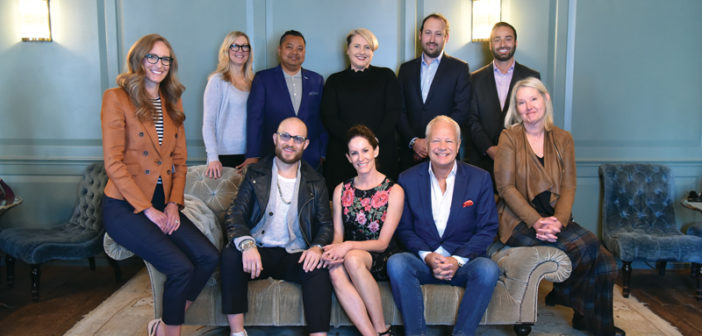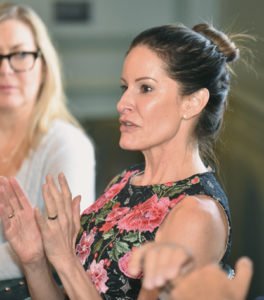NEW YORK—Creating standout properties requires collaboration and cooperation between designers and owners. While sometimes there’s tension between both parties, the end goal is to generate an ROI for the property and provide an exceptional guest experience without blowing budgets and negating gains from conceptualized stories.
Hosted by Restoration Hardware, headquartered in Corte Madera, CA, Hotel Business’ latest roundtable discussion focused on what exactly can be considered a lifestyle property (or if there’s even such a thing as a lifestyle property); how designers and owners can come together to create standout properties through design; and what the key elements are to creating a personalized property experience.
Like other industries, hospitality is known for its buzzwords. Think: authenticity, identity, personalization. Another buzzword to consider is lifestyle. What does this term mean? Who is the ideal lifestyle customer? Most importantly, how do designers and owners define the term? Despite the differences, common ground is a familiar territory for all.
Hotel Business Editor Christina Trauthwein, who moderated the 10-member roundtable, kicked off the discussion by asking a question many industry experts have been seeking the answer to over the past few years (and many more): “What is a true lifestyle hotel?”
Richard Millard, CEO and chairman of Trust Hospitality, a Coral Gables, FL-based boutique hotel management company, responded to Trauthwein’s question by challenging his peers to come up with the exact definition of a lifestyle hotel: “I don’t really think there is such a thing—or a definition—because I don’t know anybody who [has]ever said to me, ‘I want to stay at a lifestyle hotel.’ I don’t even know what it is.”
Cory Brian Ingram, SVP of creative at Dream Hotel Group, a hotel brand and management company headquartered in New York, leveraged Millard’s skepticism and curiosity by poking fun at how some brands from other industries have been slapping on the term “lifestyle” without adding any substance behind the positioning. It’s as if these brands are just trying to capitalize on trending buzzwords.
“In the beauty and fashion world, you meet so many people, and they’re like, ‘We’re a lifestyle brand,’ yet they’re creating sunscreen,” Ingram said. “You’re like, ‘Well, how? What makes you lifestyle with one sunscreen product?’ ‘No, but we’re a lifestyle brand because we did some t-shirts and have hats, and we’re about to do a partnership with a surfboard.’”
Shortly after the laughter subdued, Foiz Ahmed, president of Quadrum Hospitality Group, a New York-based investment management company, concurred with his panelists; however, he went on to offer an alternative viewpoint—introducing another term into the conversation.
“I prefer independent, right?” he said as heads around the table nodded. “It’s an independent product. It’s an independent experience. You hope that you’re one-of-a-kind… To me, take out ‘lifestyle’ because I agree that it’s so overused. It’s really more about the independent experiences and the independent products.”
While Christina Zimmer, SVP of design at Highgate Hotels, an investment and hospitality management company headquartered in New York, agreed with the essence of what the panelists were saying, she additionally pointed out the importance of recognizing how the hospitality industry has changed over time—specifically with regard to how locals view restaurants in hotels (compared to 40 years ago, more locals are now dining in restaurants at hotels in Manhattan, for example).
“I think some of the best restaurants in New York are in hotels,” she said. “I think the term comes somewhat from the idea that it’s a place that locals go, and so now, it’s part of my community, and it is independent, so it’s not a chain. I don’t see the same thing I see in Hawaii that I see in Manhattan.”
Defining a property as lifestyle can also help a brand better communicate what the property is giving to guests. “I think what it does is it tells the consumer this isn’t a vanilla experience,” said Kathleen Chiechi Flores, EVP of brands and innovation at Trump Hotels, a New York-based luxury hotel brand. “I can’t describe in the term of lifestyle of what you’re going to get, but you’re not going to get cookie-cutter, so I think there’s great value. It doesn’t define it, but it sets into its own category.” Flores’ thoughts—which were well received by her peers—raised another discussion point: How can brands stay consistent without being cookie-cutter?
Justin Jabara, VP of development at Meyer Jabara Hotels, a Danbury, CT-based management company, pointed out there’s a time and place for cookie-cutter; however, location will typically determine whether “lifestyle” elements are necessary.
“When you come to New York, you want to taste the local food and see what Brooklyn is about,” he said. “You want to feel Brooklyn when you stay in that hotel. I think that’s where you’re picking up lifestyle elements.”
Every property has a story to tell
Lifestyle properties have more than just themes; each and every one of these properties has a story to tell—from start to finish. “There’s some thought and consistency that isn’t cookie-cutter, and it just stands for something,” said Lisa Zandee, SVP of marketing and branding at HHM, a management, investment and development firm with a corporate office in New York. Many lifestyle properties aim to bring guests through defined journeys. Each journey connects with various elements throughout the property it’s in.
The property’s story is connected through more than just tangible elements, too (there’s more to the journey than the box itself). The hotel’s narrative also sits behind the brand.
“When you think about the Tommy Bahama or Harley Davidson brands, there’s a story there, whether it be the open road or whether it be sitting on the beach with a margarita… I think that it’s translating that story into the hotel,” Flores said.
There are times when a lifestyle property fails to fully connect the pieces of the story. As Ingram noted earlier, there are some brands in the industry promoting empty promises.
“I’ve also seen some hotels that are taking the idea of branding, and they’ve kind of just put the brand on it, and then you go to the website, and it’s like, ‘Wow, that looks super cool,” Zimmer said. “They made some sort of crop shot; it looks amazing. You get there, and there’s no substance behind your stay.”
All the layers have to be there when designing a property and when creating the overall story. “You have to have all the layers, right?” said Rebecca Lunceford, AVP of design and development services at Two Roads Hospitality. “We have to have the human layer, with the culture, and we layer on the design, and we layer on programming, and we layer on the amenities, so that when you arrive—from the beginning to end—we didn’t break that thread.” The entire property has to commit to the design, too, including associates interacting with property guests; otherwise, the entire story abruptly ends.
Being that there are many players involved in keeping a property’s narrative afloat—including employees of both owners and management companies—designers find themselves, more often than not, in predicaments when trying to uphold a brand’s image (e.g., budget restraints); however, fighting the battle is essential to consistency.
“It all has to tie together, and it has to speak on the digital front and social front, too,” Ingram said. “It can’t be broken. The copy has to have that tone of voice, so whatever you’re saying is consistent throughout the journey.”
Print and digital materials are part of the overall experience. “The cadence of what you read needs to match the experience you’re having because from the moment that you book it, you want to feel like I know what I’m getting, and it teases you,” Lunceford said. Guests are somewhat purchasing a performance when they book a room at a hotel.
“If we created an Instagram moment, we failed,” she vehemently said to her fellow panelists, many of whom nodded in response. “That’s not a measure of success.”
Whose story are you telling?
It’s no secret designers mix and match products to create concepts. All of the moving parts are part of the larger story; however, the products themselves are only building blocks. The designer’s role is to take the foundation and put all of the pieces together.
“It’s your responsibility to add other layers through branding, uniforms, music, landscaping, textiles, etc.—that’s your responsibility,” Ingram said. “…Let me layer. Let me do my storytelling. Let me add my narrative—make sure my branding and my creative branding agency are speaking cohesively to this concept.”
Every property—every story, for that matter—has a single voice. The property may be involved with many partnerships, but it’s the property’s responsibility to unify its voice.
“It is so important that it’s one voice, and that really is the struggle with partnering up with any design firm,” Ahmed said.
Not only should the brand connect internally but externally, as well. For example, on social media, the story should remain the same, whether it’s the brand or guest posting.
“You know exactly what you’re getting into,” he said. “You know that the corner room has this crazy sky view because the guests are photographing it, and they’re jumping on the bed, as well as what we’re posting, so the entire story has to come from one voice.”
The guest is going to see the finished product, not the foundation. The everyday consumer isn’t going to be able to recognize where a particular chair or lamp is from.
“We at this table understand we can buy the same sofa and change it completely by the fabric we put on, the details and the finishes,” Lunceford said.
Sometimes, designers are left with retelling a story: for example, the TWA hotel project at JFK airport in Queens, NY. MCR and Morse Development are in the process of reimagining the iconic TWA Flight Center as a hotel.
“The building did it for us,” said Russ Shattan, SVP, acquisitions and development at MCR, a hotel development and management services company. “It is a remarkable masterpiece. It’s unique in that the exterior of the building is protected, but so is the interior, so that brought a higher level of concept.”
Make yourself at home
Bringing elements of home on the road has been an evolving concept over the years. Not only are guests expecting to be able to use familiar technology, but they’re also looking for a comforting feeling—a home away from home. At the same time, guests are looking for a unique sense of being, as is the case with atypical residential properties. Everybody’s home has very different concepts—and that’s where guests are heading. Guests are the ones who have asked properties to carefully walk this line.
“When you’re traveling, we want you to feel like you’re somewhere special,” Flores said. “That you’re not in your home, but I think it’s the warmth. It’s that feeling of belonging. It’s that just familiar enough.”
For owners, from a design perspective, there are some cases where bringing residential elements into the room can be disastrous; however, bringing elements into the stay is a bit different. This is where properties bring familiar technologies into play for comfort.
“I have Netflix at home,” Jabara said. “I want Netflix on my television. I get it, right?”
When it comes to residential technology, though, hotels could be followers. There are additional concerns properties must consider—unlike their residential counterparts.
“You can do your technology on a unit of one, which is easy to do in your house, and then we put it in a hotel, and we have all this risk,” Lunceford said. “What if your Netflix account gets wiped? What about this and that? We worry about these things, and your credit card’s connected to it. In technology, the residential leads, and we follow a bit.”
At the end of the day, there needs to be a ROI for the property, whether that’s with regard to money or customer experience. What’s most important is: “I always say to the designers, ‘Are we going to get credit for it?’’’ Ingram said.
“You want to look at those things that the customer is going to give you a return on,” Flores said. “What the customer is going to give you credit for and appreciate. What we look at is attention to detail and to the quality of the materials because that matters to our guests. What you will lose credit for is wear and tear [in the FF&E]. So while quality design is critical, how beautiful something looks when it is brand new isn’t the only consideration. The materials need to be high quality as well.” HB





